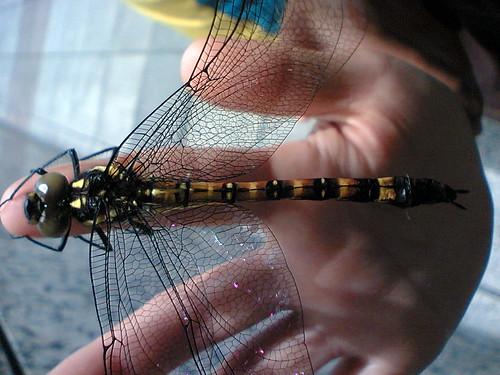
My sister spotted this HUGE dragonfly. It’s bigger than her face. But prehistoric dragonflies were as large as helicopters, probably faster than helicopters too. Ever wondered what those ate? Dragonflies aren’t called dragonflies for nothing…they are streamlined powerful for insects, and they are great fliers.
This is a dragonfly, an insect in the order of Odonata which contains also damselflies. It is a small order with just 5,000 species. Dragonflies come in many coloursincluding yellow, red and blue. But dragonflies change color at different stages – a red dragonfly isn’t always red.
Interesting fact no. 1: Odonata means “toothed” and refers to their sharp, pointed jaws. It uses its sharp pointed jaws to tear its prey into tiny chunks. Dragonflies often hunt in flight.
Interesting fact no. 2: They hold their spindly legs in front to form a small catching basket – any flying insects within reach are quickly bagged. The dragonfly will sometimes even eat its prey while in mid-flight.
Interesting fact no. 3: Dragonflies have extremely large compound eyes, as this close-up shows. The eyes cover most of the insect’s head and almost meet at the top. Each compound eye has up to 30,000 lens, each of which may help to build up a detailed picture. Dragonflies can detect movement easily and use their keen sight to track down their prey. When they are in flight, they are almost impossible to catch. I spent last summer chasing dragonflies over a pond with a net but never caught one.
How to catch a dragonfly: You can hypnotise a dragonfly by using your finger and making a loop continuously infront of the dragonfly, and with your other hand, sneak up from behind and grab the dragonfly’s wings firmly so that you don’t tear the wings.
Interesting fact no. 4. Dragonflies are among the fastest insect fliers. They can race along at speeds of up to 95 km/h. Unlike other insects, their wings move independently. As each wng circles, it makes a figure of eight. This helps the insect to accelerate, brake and hover in one place — and also to ster with great accuracy. Dragonflies are larger insects but they were larger in prehistoric times. They lived before dinosaurs did and flew on Earth 300 million years ago. Prehistoric dragonflies had wingspans that measured 60 cm across. No modern species comes close.






